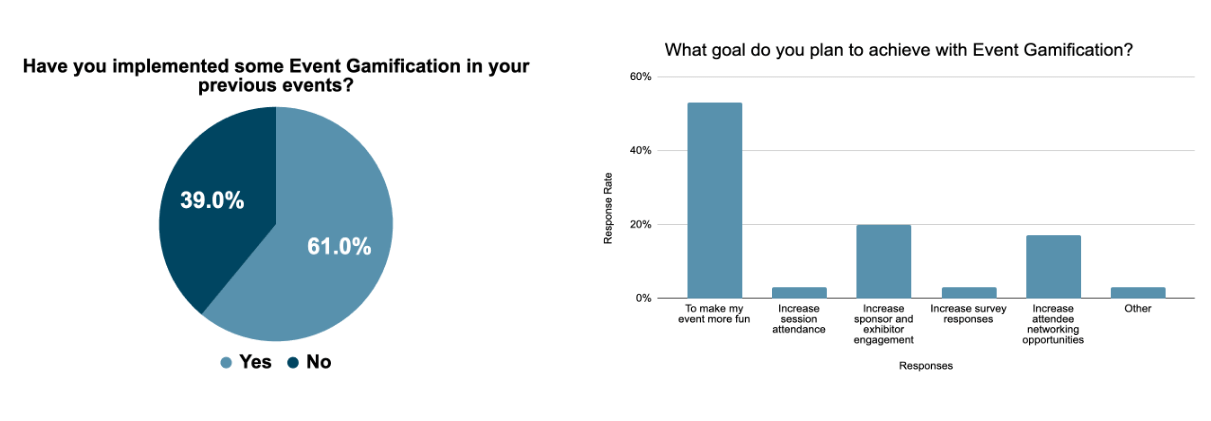Being an event organizer is one of the toughest jobs out there. Not only do you have to deliver an engaging event experience that hits all your goals, but at the same time, you want to make it an entertaining experience in order to ensure attendees keep coming back for future iterations. A great way to maintain this sense of fun is through event gamification!
In the latest addition to our Event Insider series, we invited talented organizers Earl Saline, Amy Moore, and Jonathan Lopez to talk about how they were able to gamify their events. We’ve compiled the best ways they were able to use gamification, and hopefully, this gives you a better idea of what gamification is, and how you can use it to improve your event!
What is Event Gamification?
Gamification is the process of adding game mechanics into nongame environments in order to increase participation, engagement, and interest. By adding fun and immersive mechanics, such as a simple point system or a friendly competition, attendees become incentivized to engage with each other and are more likely to participate.
For example, by adding a fun gamified system to otherwise mundane event activities, such as rewarding points for attending sessions or engaging with your exhibitors, these same activities suddenly become a game that attendees have a desire to win. This can be useful if you want to incentivize attendees to come back for future editions of your event, or if you struggle to drive engagement at your events.
How Often do Organizers Use Event Gamification?

When polled in our Event Insider session, over 60% of organizers present noted that they used event gamification in their events. Of that 60%, 50% of them mentioned that they utilized gamification to make things more fun, 20% said they made use of it to increase sponsor and exhibitor engagement, another 20% mentioned they used gamification to improve attendee networking, and the last 10% gave other reasons.
5 of the Most Effective Event Gamifications
“Gamification is worth the investment of your time, 100%, no question about it. My attendees come up to me all the time and wonder why we didn’t implement gamification into our events sooner!”
– Amy Moore, Events Manager @ Public Relations Society of America
Point Based Leaderboard: Implementing a leaderboard is one of the easiest ways to begin gamifying your event. A place that ranks attendees based on a point system is one of the simplest ways to tap into human’s innate competitive nature and begin fostering higher levels of engagement and activity.
Whova makes implementation of this method a breeze. By already coming equipped with an in-app leaderboard that doesn’t require any manual creation, all organizers have to do is set up from the dashboard and watch their attendees compete.
Whova’s leaderboard grants points to attendees for completing a large variety of activities in the app, such as community board participation, sharing articles, and even sharing icebreakers. Try rewarding prizes to the top 3 placeholders on your event’s leaderboard, further creating a desire for your attendees to come out on top.
Photo Contest: Creating a photo contest for your attendees to participate in is another great way to utilize event gamification. Not only is it good for driving engagement, but visual assets, such as photos, breathe another sense of realism into your event. For example, if you’re running an event with college educators, try implementing a photo contest that requires them to take photos next to important landmarks on their campus!
With Whova, much like the leaderboard, this feature is already pre-made, saving you the hassle of creating it from scratch, so setting up this event gamification feature is extremely easy. All an organizer has to do is enable it from the dashboard and let their attendees begin posting photos.
Caption Contest: Going hand in hand with the photo contest, implementing a caption contest is an excellent way to get your attendees’ creativity flowing. Put your event-goers’ minds to the test by allowing them to engage with photos posted by others, fostering engagement between attendees as well. Allow them to create captions for photos in the photo contest, and then award the win to the best one!
Setting up this feature in Whova is a breeze. Simply enable the feature in the dashboard and watch your attendee’s come up with stunning photo captions. Our organizers in this Event Insider edition were big fans of this gamification, noting that the amount of payoff it gave largely dwarfed the investment. By utilizing both the photo and the caption contest, attendees will feel mentally stimulated and excited.
Trivia Contest: Including a variation of a trivia contest can do wonders for your event. However, while a bit audience dependent, this may not be the best choice for some events.
While a trivia contest can drive engagement, setting up this method is not the easiest. Such a contest can require large amounts of time and effort from you in order to come up with interesting questions.
Community Board: Implementing a community board, or any sort of centralized hub for engagement and information, into your event can do wonders. By fostering natural connections that don’t require micromanagement from an organizer or staff member, attendees will be motivated to grow their own relationships with other event goers.
With Whova, organizers can easily set up the community board by enabling it in the dashboard. This feature goes hand in hand with the leaderboard, as participation in the community board will allow attendees to gain points and move up through the ranks. Furthermore, the Whova community board isn’t just useful for gamification, but also for letting your attendees get to know each other!
How Event Gamification Can Improve Your Event
“It (gamification) is definitely worth the investment. In terms of investing money, to me, it’s really just investing my time. Gamification is a great use of that. It’s both fun for attendees, and fun for us as organizers. Gamification is here to stay.”
– Jonathan Lopez, Sr Manager of Operational Effectiveness, Partnership for College Completion
Making events more fun: An extremely popular purpose of implementing event gamification is to make events more fun. When something is fun, participants will be motivated and encouraged to come back in the future.
Increasing sponsor and exhibitor engagement: Event gamification can do wonders for taking sponsor and exhibitor engagement through the roof. For example, try implementing Whova’s passport contest into your event. This contest incentivizes attendees to interact with your participating exhibitors and sponsors by granting them a digital stamp for each booth they visit.
Improving attendee networking: By utilizing gamification, networking between your attendees becomes both encouraged, and a fun experience. Whova’s community board feature already fosters natural connections between event goers, but when you combine the leaderboard, networking is truly taken to the next level.
Tailor Gamification to Your Event’s Specific Needs: While event gamification as a whole is useful for general engagement, organizers can dive a bit deeper to figure out which methods are the right fit for their event.
Organizer Amy Moore noted that her PR conferences tend to have more outgoing audiences, making the community board a big hit. Jonathan Lopez, another organizer, acknowledged that his audience of mostly academic professionals were more inclined to trivia questions, which is the route he took.
Utilize Gamification for Your Event Now!
Event gamification is a powerful strategy that event organizers use to enhance engagement and create a more enjoyable experience for attendees. It involves incorporating game elements, such as leaderboards and contests, into non-gaming environments like event activities. When using Whova to manage your event, implementation of these methods is a breeze.
For more information on how Whova can make gamifying your event a seamless experience, just click before for a free demo!
